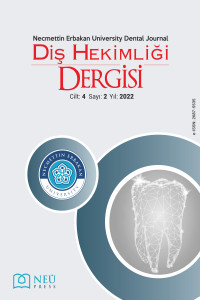Gömülü Yirmi Yaş Dişi İle İlgili Youtube Videoları Hastalar İçin Yararlı Mı?: Kesitsel Bir Çalışma
Gömülü üçüncü molar, İnternet, Hastalar
Are Youtube Vıdeos Related To Impacted Thırd Molar Useful For Patıents?
___
- 1. Bishara SE, Andreasen G. Third molars: a review. Am J Orthod. 1983;83:131–7.
- 2. Biggs TC, Bird JH, Harries PG, Salib RJ. YouTube as a source of information on rhinosinusitis: the good, the bad and the ugly. J Laryngol Otol. 2013;127:749–54.
- 3. AlGhamdi KM, Moussa NA. Internet use by the public to search for health-related information. Int J Med Inf 2012;81:363-73.
- 4. Noll D, Mahon B, Shroff B, Carrico C, Lindauer SJ. Twitter analysis of the orthodontic patient experience with braces vs Invisalign. Angle Orthod 2016;87:377-83.
- 5. Lee JS. YouTube as a source of patient information on gallstone disease. World J Gastroenterol. 2014;20:4066-70.
- 6. Greene JA, Choudhry NK, Kilabuk E, Shrank WH. Online social networking by patients with diabetes: a qualitative evaluation of communication with Facebook. J Gen Intern Med 2011;26:287-92.
- 7. Kumar N, Garg N, Venkatraman A, Pandey A. Are video sharing websites a useful source of information on hypertension? J Am Soc Hypertens. 2014;8:481–90.
- 8. Stellefson M, Chaney B, Ochipa K, Chaney D, Haider Z, Hanik B, Chavarria E, Bernhardt JM. YouTube as a source of chronic obstructive pulmonary disease patient education. Chron Respir Dis. 2014;11:61–71.
- 9. Al-Silwadi FM, Gill DS, Petrie A, Cunningham SJ. Effect of social media in improving knowledge among patients having fixed appliance orthodontic treatment: a single-center randomized controlled trial. Am J Orthod Dentofacial Orthop 2015;148: 231-7.
- 10. Abukaraky A, Hamdan AA, Ameera MN, Nasief M, Hassona Y. Quality of YouTube TM videos on dental implants. Med Oral Patol Oral Cir Bucal. 2018;23:463-8.
- 11. Gaş S, Zincir ÖÖ, Bozkurt AP. Are YouTube Videos Useful for Patients Interested in Botulinum Toxin for Bruxism?. J Oral Maxillofac Surg. 2019;77:1776–83.
- 12. Starman JS, Gettys FK, Capo JA, Fleischli JE, Norton H J, Karunakar MA. Quality and content of Internet-based information for ten common orthopaedic sports medicine diagnoses. J Bone Joint Surg Am. 2010;92:1612–8.
- 13. Fox SR, Rainie L. E-patients and the online health care revolution. Physician Exec. 2012;28:14-7.
- 14. Murray E, Lo B, Pollack L, Donelan K, Catania J, Lee K, Zapert K, Turner R. The impact of health information on the Internet on health care and the physician-patient relationship: national U.S. survey among 1.050 U.S. physicians. J Med Internet Res. 2003;5:e17.
- 15. Koller U, Waldstein W, Schatz KD, Windhager R. YouTube provides irrelevant information for the diagnosis and treatment of hip arthritis. Int Orthop. 2016;40: 1995–2002.
- 16. Ho A, McGrath C, Mattheos N. Social media patient testimonials in implant dentistry: information or misinformation? Clin Oral Implant Res. 2017;28:791–800.
- 17. Özdal ÖZ, Bozkurt AP, Gaş S. Potential Patient Education of YouTube Videos Related to Wisdom Tooth Surgical Removal. J Craniofac Surg. 2019;30:e481–4.
- 18. Susarla SM, Dodson TB. Risk factors for third molar extraction difficulty. J Oral Maxillofac Surg. 2004;62:1363–71.
- 19. Chuang SK, Perrott DH, Susarla SM, Dodson TB. Risk factors for inflammatory complications following third molar surgery in adults. J Oral Maxillofac Surg. 2008;66:2213–8.
- Yayın Aralığı: Yılda 3 Sayı
- Başlangıç: 2019
- Yayıncı: Necmettin Erbakan Üniversitesi
İnternet Ortamındaki Şeffaf Plak Tedavisi ile İlgili Bilgilerin Okunabilirlik Analizi
Gömülü Yirmi Yaş Dişi İle İlgili Youtube Videoları Hastalar İçin Yararlı Mı?: Kesitsel Bir Çalışma
Dilek MENZİLETOĞLU, Arif Yiğit GÜLER, Bozkurt Kubilay IŞIK
Emine Begüm BÜYÜKERKMEN, Haydar Ali ÖZKALE
Arslan TERLEMEZ, Sare Sena PEKDEMİR, Şakir GICA
Ahmet Ertan SOĞANCI, Alparslan ESEN, Şule Nur METLİ
İmplant Destekli Overdenture Protezlerde Ataşman Seçim Kriterleri Ve Önemi
Beste Burcu UZ, Bike ALTAN, Şevki ÇINAR
Endodontide Blue-wire ve Gold-wire Teknolojisi ile Üretilen Yeni Nesil Nikel Titanyum Eğeler
